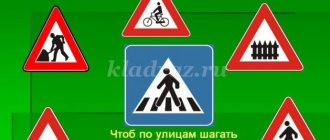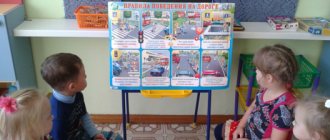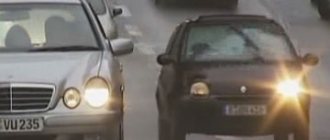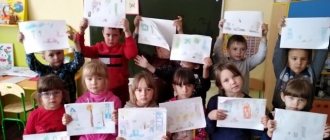Outdoor games with elements of traffic rules for summer holidays
Outdoor games with elements of traffic rules for primary schoolchildren
Outdoor games help younger schoolchildren gain knowledge of traffic rules in an entertaining way, instill in them the skills and habits of correct behavior on the street, arouse interest in the movement of vehicles and pedestrians, in the transport itself, respect for the work of vehicle drivers, and the work of traffic police officers. In the process of games, children consolidate and improve their skills and abilities to act in constantly changing conditions and to best respond to an unexpected new situation. The game teaches the child, when interacting with peers in a team, to subordinate his interests to the interests of others.
Game "Bus"
“Buses” are teams of children: “driver” and “passengers”. Flags are placed 6-7 m from each team. On the command “March!” The first players - "drivers" at a fast pace (running is prohibited) head to their flags, go around them and return to the columns, where they are joined by the second players, and together they again make the same path, etc. The players hold each other by the elbows. When the bus (the front player - the “driver”) returns to its place with a full complement of passengers, it must sound a whistle. The team that arrives at the final stop first wins.
Game “Traffic Inspector and Driver”
The game involves 5-6 people.
On the playing area, 4-5 parallel lines are drawn with chalk, indicating the stages of movement. Players (drivers) place their cars (chairs) behind the last line and sit on them. Drivers have driver's license coupons (cardboard rectangles). A traffic inspector sits on the opposite side of the platform, facing the drivers, with road signs and scissors in his hands. These scissors are needed to cut out the license of an offending driver. The traffic inspector shows road signs to drivers one by one. The driver, who has correctly explained what the sign requires, advances to the next line. The driver, who failed to explain this, receives a puncture (a corner of the driver's license is cut off with scissors) and a remark from the traffic inspector; his car remains in place. A player who receives four punctures is eliminated from the game. A driver who passes all stages without any comments becomes a traffic inspector, and a traffic inspector becomes a driver. The game repeats itself. Drivers who are eliminated from the game receive new driver's license coupons and are included in the game.
Game "Be careful!"
Children remember what to do and when to do it. They walk in a circle and carefully listen to the signals of the traffic controller. At the signal: “Traffic light!” - stand still; at the signal: “Transition!” - walk; at the signal: “Car!” - pretend to be holding the steering wheel in your hands.
Game "Funny Tram"
We are cheerful trams, We don’t jump like bunnies, We ride on the rails together. Hey, come sit with us if you want! Children are divided into two teams. One team - trams. The tram driver holds a hoop in his hands. The second team is passengers, they take their places at the bus stop. Each tram can carry only one passenger, who takes his place in the hoop. The final stop is on the opposite side of the hall.
Attraction game “Attention, pedestrian!”
To play this game you need three wands, painted in three colors of traffic lights. The traffic controller, a senior student, shows the guys lined up in front of him alternately one of three rods. Participants in the game take a step back when they see a red rod, stand when they see a yellow one, and two steps forward when they see a green one. The traffic controller fines the one who makes a mistake and deprives him of the right to participate in the game. The winner is the one who never makes a mistake. The winner is awarded a prize: a badge, a postcard, a book, etc.
Game "Garage"
At the corners of the site, 5-8 large circles are drawn - parking lots - garages. Inside each parking lot, draw 2-5 circles - cars (you can put hoops). The total number of machines should be 5-8 less than the number of players. Children walk in a circle, holding hands, to the sound of music. As soon as the music ends, everyone runs to the garages and takes a seat in any of the cars. Those left without a place are eliminated from the game.
Game "Trucks"
The players hold car steering wheels in their hands - they are “trucks.” They need to deliver urgent cargo. Each person has a small bag of sawdust or sand on their head. Who can run fast enough to overtake all their rivals without dropping their load?
Game "YES or NO"
The teacher or one of the children walks between the rows of desks and turns to one or another student with some question, for example: “Are you crossing the road at a red traffic light?”, “Are you riding a scooter in the yard?”, “They say that you don’t give up your seat to elders in public transport. This is true?". You must answer quickly and be sure to begin your answer with “yes” or “no.” When answering a question positively (“Yes, I only ride a scooter in the yard”), you must simultaneously turn your head from left to right, and when answering negatively (“No, I give way to older people in public transport”), you must shake your head from top to bottom (as, for example, accepted among the Bulgarians). Since these movements are completely unusual, many make mistakes and involuntarily accompany the answer with the wrong head movements, causing laughter and animation in those around them.
Game “Road, transport, pedestrian, passenger”
Children form a circle, and a traffic controller stands in the middle of it. He throws the ball to one of the players, while pronouncing one of the words: “road”, “transport”, “pedestrian”, “passenger”. If the driver said the word “Road!”, the goth who caught the ball must quickly name a word related to the road. For example: street, sidewalk, curb, etc. On the word “Transport!” the player answers with the name of a vehicle; to the word “Pedestrian!” you can answer with the words “traffic light”, “crossing”, etc. Then the ball is returned to the traffic controller. The wrong player is eliminated from the game.
Game "Road - not road"
The playing field is drawn into a line, where each line is separated from the other by one step (you can play on a wide ladder), the players stand behind the last line and the driver throws the ball to them one by one, calling out different words. If a “road” word sounds, the player must catch the ball, “non-road” - miss or throw it away; if the player’s actions correspond to the named word, the player moves to the next line (to the next step). The one who crosses the last line first wins and becomes the driver.
Game "Hare"
A bunny rides on a tram, A bunny rides, he reasons: “If I bought a ticket, Who am I: a hare or not?”
A. Shibaev
The tram “conductor” sells tickets to passengers who sit on chairs - “seats on the tram.” But there are one fewer chairs than passengers. As soon as all the tickets are sold and someone is left without a ticket, the conductor catches up with this “hare”, and the stowaway runs away.
Game “Remember the traffic controller’s signals”
Here at the post at any time there is a familiar guard.
He controls everyone at once who is in front of him on the pavement. No one in the world can do this with one movement of the hand. Stop the flow of passers-by and let trucks pass. Children are divided into teams, and a captain is chosen for each of them. The teams are located behind the starting lines - one opposite the other. The distance between teams is 20-30 m. In the middle of the site, between two lines that limit a strip 2-3 m wide, flags are placed (or laid out) in a checkerboard pattern. At a signal from the traffic controller (red light - arms extended to the sides or lowered - “stand”; yellow light - right hand with a baton in front of the chest - “get ready”; green light - the traffic controller faces the pedestrians sideways, arms extended to the sides or lowered - “go”) players quickly run up to the flags and try to collect as many of them as possible. After a set time, at the command of the traffic controller, the children return to their places and quickly form a line. Captains collect and count the flags brought by their team's players. One point is awarded for each flag. The team with the most points wins. Rules of the game: 1. During the run, the player is allowed to collect any number of flags lying on the ground.
2. It is prohibited to take away flags from each other. 3. You cannot step beyond the lines limiting the space for flags. 4. Team captains play on equal terms with everyone. Game "Knowledgeable Pedestrian"
There are a lot of traffic rules in the world, It wouldn’t hurt us to learn them all, But the main rule of traffic is to know how to do the multiplication tables: On the pavement - don’t play, don’t ride, If you want to stay healthy! The game is played on the site in the form of an excursion with an element of competition. Children line up in teams. They must walk the path, for example, from school to library. When approaching an intersection or pedestrian path, children must stop and complete a practical task posed in connection with approaching traffic and an active traffic light, then ask: “Street, street, can we cross the road?” To which “Street” (a high school student, for example) replies: “It’s possible if you answer me one question.” Asks a question about traffic rules. And so at every intersection. The detachment that answers all the questions correctly will arrive earlier at the designated point, where it will be awarded the “Excellent Pedestrians” pennant.
Game "Walking along the path"
Players walk along the path, naming at each step, for example, road signs, etc. The one who takes the most steps and names the most words wins. The game “Whoever is named, catches it.” The players sit in a circle. In the center is a traffic controller (driver). He calls the name of one of those standing in a circle and throws the ball to him. The person named catches the ball, names some type of transport and throws the ball to the traffic controller. The one who did not catch the ball or did not say the word becomes the driver. The winner is the one who has never been a traffic controller.
Game "Catch - Don't Catch"
Participants in the game, 6-8 people, line up half a step from each other. The leader is 4-5 steps away from the players with the ball, throws it to any player, while pronouncing words, for example: “road”, “crossing”, “road sign”, etc. (in this case the ball must be caught) or words denoting any other objects (in this case the ball should not be caught). The one who makes a mistake takes a step forward, but continues to play. If he makes a second mistake, he is eliminated from the game. It is very important that the driver first says the word and then throws the ball.
Game "Name the Sixth"
Several people play. The driver turns to someone, throws a ball into his hands, says “Name the sixth” and lists, for example, five types of transport (or road signs, etc.). The person asked to continue the list must catch the ball and quickly add another name without repeating what was listed before. If the words follow immediately, the person answering begins to ask questions; if not, the driver remains the same.
Game "Find the Rod"
Before the start of the game, the leader hides the rod for regulating traffic, but so that it can be seen. The players stand in a line or column, one at a time. At the leader’s signal, the players move in a column, one at a time, around the hall, and everyone tries to be the first to notice the hidden object. The player who sees the object first puts his hands on his belt and continues walking, without showing others where the hidden object is. The leader, to make sure that the player really found the item, can approach him and quietly ask about it. The game ends when all or most of the players have found the item. The player, having noticed a hidden object, must not stop, slow down, touch or in any other way indicate to other players the location of the hidden object.
Game "Find a Pair"
The players are given strips of paper with images of road signs. Without talking to each other, everyone must find a mate, that is, a partner with the same picture. Couples stand in a circle. As an option: each pair tells what their road sign means.
Game "Unusual Road Sign"
In this game, children are asked to come up with an unusual road sign. You need to choose one of the objects from the surrounding world and try to transfer its properties to a road sign. At the same time, the most fantastic, most incredible options are possible. The teacher invites the children to think of some object of living or inanimate nature (cat, tree, flower, house, etc.). The teacher asks: “Could an unusual road sign somehow resemble a cat?” The children answer: “Maybe!”
Game "Traffic Lights"
The traffic light is red! The path is dangerous - there is no passage! And if the yellow light is on, He says “get ready.” Green flashed ahead - the way is clear - cross. In the game, all children are “pedestrians.” When the traffic controller shows a yellow light at the traffic light, all the students line up and prepare to move. When the green light turns on, you can walk around the entire hall, run, jump. When the light is red, everyone freezes in place. The one who makes a mistake is eliminated from the game. When crossing the street, follow the traffic lights.
Game "Spiderweb"
Children sit in a circle. The driver, a traffic controller, has a ball of thread in his hands. He throws a ball to any of the children, naming the cause of accidents on the roads: “Sasha, walking along the roadway when there is a sidewalk is dangerous.” Sasha holds the thread, and the presenter throws the ball further: “Sergey! Leaving a stationary car unexpectedly can lead to an accident.” Sergei holds the thread, and the presenter throws the ball further: “Olya! Children playing on the roadway is very dangerous.” When all the children take part in the game, they will have in their hands a “web” of stories about the causes of accidents on the roads.
Game "Trip to Moscow"
To play, you need chairs - one less than the number of players. The chairs are placed tightly in a circle, one next to the other, with the seats facing outward. Each player takes an empty seat. The driver does not need a chair. He walks around the players, holding a flag in his hand, and says: “I’m going to Moscow, I invite those who wish.” All the guys one by one join him. The driver says: “We are going to Moscow by bus (train, plane)” - and at the same time speeds up his pace. “The bus is picking up speed,” the driver continues and starts running. “Moscow is very close,” he announces (the run slows down). "Attention, stop!" — the driver’s command is suddenly heard. At this command, everyone runs to the chairs. Everyone tries to occupy any free space. The driver also tries to take a seat. The one who is left without a chair becomes the driver, gets a flag and repeats the game. The driver can take the students away from the chairs, lead them across the hall, for example, and give the command “Landing!” unexpectedly anywhere.
Game "Crossroads"
The leader stands in the center of the intersection - this is a traffic light. Children are divided into two groups - pedestrians and cars. The presenter's whistle sounds. The intersection “comes to life”: pedestrians are walking, vehicles are moving. If violations of traffic rules are committed, the presenter whistles and calls the name of the violator. He leaves the game. Those who have no mistakes win. A motor rally on tricycles or scooters is organized for the winners.
Game "Search for the Wand"
Two chairs are placed at a distance of 8-10 m from one another and a staff is placed on each. The players stand near the chairs, facing each other. They are blindfolded. At the leader’s signal, each of them must go forward, go around his friend’s chair, go back, find his rod and knock it on the chair. The one who completes this before the opponent wins.
Game "Different Cars"
The leading traffic controller exclaims: “Trucks!”, and the “trucks” quickly drive towards their line. And the “passenger cars” follow them, trying to make them look bad. The presenter remembers (or someone notes) the number of those covered. It’s the turn of the passenger cars to go to their road. And among them there will be losers who were overtaken by trucks. And so on several times. The presenter does not necessarily call the commands strictly in order - it will be more interesting if he unexpectedly calls one several times in a row. It is only important that the total number of trips for trucks and cars ends up being the same. To create more tension in the game, team names should be pronounced syllable by syllable. Here it sounds: “Ma-shi-ny easy-to-you...”
Game "Traffic Controller"
While walking in a column, one at a time, the teacher (he goes first) changes the position of his hands: to the side, on the waist, up, behind the head, behind the back. Children perform all the movements behind him, except for one - hands on the belt. This movement is prohibited. The one who makes a mistake leaves the ranks, stands at the end of the column and continues the game. After some time, another movement is declared prohibited.
Game “Assemble a traffic light”
The teams are given a baton and the task is explained: each team member must participate in assembling a traffic light from rectangles. The winner is the team that finishes assembling the traffic light earlier and without errors. Two boxes contain seven gray rectangles and one colored rectangle: red, yellow and green. At a signal, team members run up to the boxes, take out rectangles from the boxes, return to their place, passing the baton to the next one, each next participant takes another rectangle from the box, continuing to assemble the traffic light. The rectangles are placed one on top of the other in the following sequence: gray, gray, red, gray, yellow, gray, green, gray, gray, gray.
Game "Traffic Light"
The field is limited on 4 sides (depending on the number of players) like a pedestrian path, beyond which you cannot run. The driver in the center of the playing field, turning away, names the color. Those players who have the named color on their clothes calmly move on; the remaining participants - the “violators” - must run across the “road”, and the grumpy “violator” becomes the driver.
Game "Traffic Signals"
Two teams of 12-15 people line up in a semicircle, one to the left, the other to the right of the leader. In the hands of the traffic light leader are two cardboard circles, one side of which is yellow, the other side of the circles is different (red and green). The presenter reminds the children how important it is to follow the traffic rules on the street, cross it only in designated places where the sign “crossing” is written, first look to the left, then to the right to make sure that there are no cars nearby, and where there is a traffic light, carefully keep an eye on him. After this, the presenter reads S. Mikhalkov’s poems to the children. The guys suggest the missing words in unison. If the light turns red, it means moving... (dangerous). The green light says: “Come on, the path... (open). Yellow light - warning: Wait for the signal to... (move). Then the presenter explains the rules of the game: - When I show a green traffic light, everyone marches in place (you need to start with the left foot), when it’s yellow, they clap their hands, and when it’s red, they stand still. Anyone who confuses the signal takes a step back. Signals should change unexpectedly, at different intervals. The team that has the most participants left at the end of the game wins.
Game "Let's get a driver's license"
The game involves 5-7 people: “traffic inspector” and “drivers”. The players choose a driver (traffic inspector). He is given road signs (from the "Wall Road Signs" set) with their meanings written on the back. The traffic inspector shows road signs (familiar to the students), changing them one by one, and the drivers explain the meaning of the signs. For the correct answer, drivers receive a point (they are given a colored token, a piece of cardboard). At the end of the game, it is counted who received the most tokens. He is awarded the title of 1st class driver, others - 2nd and 3rd class drivers, respectively. The player who takes first place becomes a traffic inspector. The game repeats itself.
Game "Collect the picture"
From each team (“Traffic Light”, “Car”, “Pedestrian”, etc.), a player is selected to participate in the game using a counting rhyme. You need to collect the parts of the picture scattered on the road to get a picture with the same image as the name of the team.
Taxi game
A group of children is divided into pairs. Each pair (“Taxi”) stands inside one hoop (“Taxi”). Each child holds his or her half of the circle (usually at waist or shoulder level). Children run around standing inside hoops while music plays. The two students must move at the same speed and in the same direction. Every time the music stops, children from two different hoops join together. The game continues until the maximum number of children fit inside the hoops (up to 6-8 people).
Game "Move slower..."
The driver stands on one side of the playing field, the players stand on the other end, the driver turns away and says: “If you drive more slowly, you will go further, one, two, three, stop” - and turns around. Players who are running towards the driver at this moment should freeze. Anyone who did not stop in time returns to the starting line. The winner who is the first to reach the driver's territory becomes the driver himself. The essence of the game is that the phrase can be cut off in any way (an element of surprise is introduced), but the last word should still be “stop”, only after which the driver can turn around.
Car relay game
Children are divided into 2-4 teams with the same number of players and line up in columns one at a time, one parallel to the other. Those playing in teams take the names of the cars: “Moskvich”, “Mercedes”, “Zhiguli”, etc. A starting line is drawn in front of the players in front, and a stand (mace) is placed at a distance of approximately 10-20 m from each column. The finish line is drawn at a distance of 2 m from the start. The traffic controller loudly calls any car. Players with the name of this car run forward, run around the object standing in front of them and return back. The first one to reach his team wins a point for his team. The traffic controller calls cars randomly, some of them may be called twice.
We recommend watching:
Game on traffic rules “Field of Miracles” with a presentation for primary schoolchildren of grades 2-4. Quest game on traffic rules in elementary school. Crossword puzzles on traffic rules for grades 3-4 with answers. Game competition on traffic rules for elementary school, grades 3-4.
Similar articles:
Game on traffic rules for 1st grade
Game program on traffic rules for 2nd grade
Game event on traffic rules for primary schoolchildren
Game traffic rules quiz for primary schoolchildren of 3rd grade
Outdoor games according to traffic rules for elementary school






